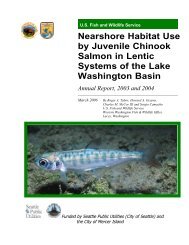2006 Water Comprehensive Plan - City of Bellevue
2006 Water Comprehensive Plan - City of Bellevue
2006 Water Comprehensive Plan - City of Bellevue
- No tags were found...
Create successful ePaper yourself
Turn your PDF publications into a flip-book with our unique Google optimized e-Paper software.
equired by state or federal regulations to conduct DBP monitoring, <strong>Bellevue</strong> has beenmonitoring those DBPs regulated by the Stage 1 D/DBP Rule since the first quarter <strong>of</strong> 2004.Prior to this, SPU performed DBP monitoring in <strong>Bellevue</strong>’s system. This monitoring has beenconducted in anticipation for the upcoming Stage 2 DBP Rule, which will apply to <strong>Bellevue</strong>, andto ensure public health protection. DBP monitoring has been conducted quarterly at locationsanticipated to be consistent with upcoming IDSE and Stage 2 requirements. The DBP levels inthe voluntary samples are all below the MCLs established in the Stage 1 D/DBP.<strong>Bellevue</strong>’s compliance with these regulations during the last six years is detailed below.Disinfection By-Product MonitoringRegulatory RequirementsSome disinfection by-products (DBPs), such as trihalomethanes, have been shown to causecancer and negative reproductive health effects. Until 2002, <strong>Bellevue</strong> was required to samplequarterly for Total Trihalomethanes (TTHMs). The Maximum Contaminant Level (MCL) forTTHMs was 100 µg/L. In 2002, the federal Stage 1 Disinfectant/Disinfection By-Product Rulebecame effective for surface water supplied systems with more than 10,000 customers, makingthe previous TTHM requirements no longer applicable. The TTHM MCL was reduced from 100to 80 µg/L and an MCL was added for the total <strong>of</strong> five haloacetic acids (HAA5) at 60 µg/L. Asadopted in the WAC 246-290, the Stage 1 DBP requirements were not enforced for systems thatpurchase all <strong>of</strong> their water and do not apply any disinfectant.<strong>Bellevue</strong> Status<strong>Bellevue</strong> participated in SPU’s TTHM Regional Monitoring <strong>Plan</strong>, which resulted in reducedmonitoring. TTHM monitoring was conducted by SPU quarterly at two locations in <strong>Bellevue</strong>’sdistribution system, one served by the Tolt supply and the other served by the Cedar supply.Annual average TTHMs from 1998 through 2003 are shown in Table 10-2. Between 1999 and2002, <strong>Bellevue</strong> collected 12 HAA5 samples per DOH requirements at location BE-S15, thataveraged to 37 µg/L. The monitoring sites were changed in 2001, and the Tolt River supplybecame filtered, reducing DBP precursor levels entering <strong>Bellevue</strong>’s distribution system.<strong>Bellevue</strong> has been in compliance with the DBP MCLs throughout this period.10-4
















